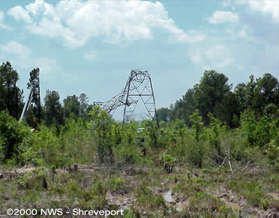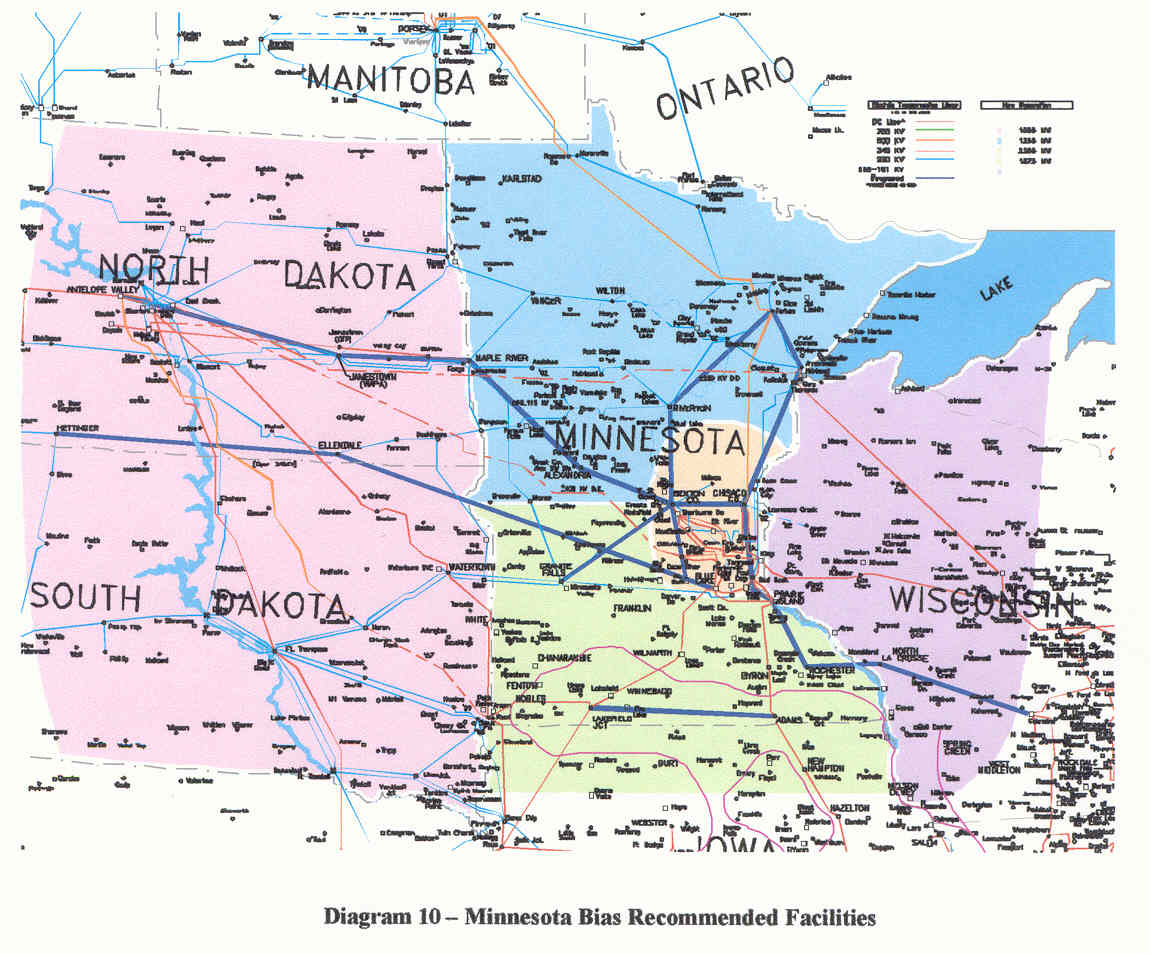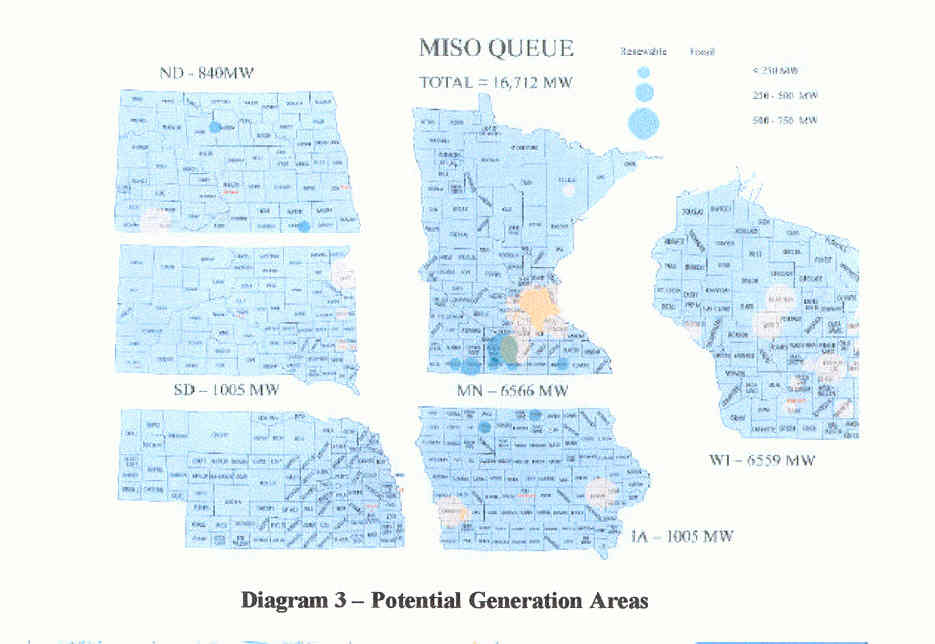TRANSMISSION FOR DUMMIES #1
June 22nd, 2005

Partisan Politics v. Putrid Policy
Ray Cox?s labeling of my substantive energy policy criticisms as ?Partisan Politics? shows that he doesn?t know the difference between partisan politics and putrid policy, and that?s too bad, because he?s up in the legislature voting on these bills. I believe in equal opportunity accountability, holding everyone accountable for their positions and actions. In this case, legislators on all sides voted for SF1368 — it’s hardly a partisan issue.
The Transmission Omnibus Bill from Hell is about our energy future, the path the legislature chose to take, which in this case is a transmission policy disaster. Ray Cox claims to be an ?environmental? legislator, so I expect public statements about energy to reflect that perspective, and to reflect education about transmission issues and the interconnection of energy. I hate to see legislators voting like lemmings ? this transmission bill takes us right over the cliff. What does it take to get the legislature to put the dots together and see where it?s going? What does it take for legislators to do their homework and to be independent thinkers who stand up for the public interest instead of special interests who benefit while the public suffers and is put at risk? What does it take for legislators to understand that even the industry recognizes that we have an electricity glut and the no market for new generation is severely limited? If the industry acknowledges the market glut, shouldn’t the legislators be paying attention?
Putrid policy results from a lack of critical thinking, the transmission line between the faulty end point assumptions is an example. It’s confirmed in the Sierra Club Newsletter this month, the same article Ray Cox raved about. I wish Ray would have read further in Michael Noble?s piece, on page 5, because he discloses our transmission nightmare hell/future just as I?ve described it ? new transmission superhighways roaring across the state. (When you consider transmission, remember that, as Jim Alders of Xcel said testified at the SW MN 345kV hearing, ?electrons don?t know if they?re coal or nuclear or wind,? and transmission cannot discriminate and cannot choose to transmit one type of generation and not another under the FERC rules).
Many of you have been to my Transmission 1001, but let?s review and get down to basics, get more elementary, more pictures:
TRANSMISSION FOR DUMMIES #1: MORE ELECTRICITY — IT?S NOT NEEDED

? We will not swelter without air conditioning in an incubator without a job!

? We will not freeze in the dark on a respirator without a job!
Here?s Michael Noble?s vision via Northstar Sierra Club?s newsletter:
Instead of planning transmission to serve new coal plants, let’s begin discussing a project that combines the following: renewable energy from wind farms and bio-gas plants, a new high-capacity border-to-border powerline across southern Minnesota and northern Iowa, and as many locally owned energy projects as can be organized along the route. Let’s dub this project Next Generation, a $5 billion project completed within five years. What if this Next Generation project offset the need for two or more coal plants? What if this Next Generation project brought wealth and opportunity to 20+ communities? The stage is already being set.

As Michael Noble well knows, coal plants will be served by the transmission lines in SW Minnesota. Transmission reservations are non-discriminatory, and are allocated on a “first come, first serve” basis.
The Transmission Omnibus Bill from Hell confers benefits on special interests. Who will benefit from construction of transmission with minimal and superficial review of projects, who will benefit when the planned new coal plants are built, and who benefits when the infrastructure is put in place and it?s harder to free ourselves from the clutches of central station coal in the Dakotas? New coal plants are coming on line, such as Big Stone and Coal Creek?s additions of 1,100MW, going through the transmission study and state permitting processes right now and made possible only because of the promise of transmission in this bill. These two new coal plants just across our border will drop mercury on us and further pollute Minnesota. Already all, ALL, of the ?impaired waters? in Rice County are contaminated with mercury. Aren?t these new coal plants and mercury polluted waters in Minnesota a problem for all who claim to be against coal plants and mercury in the water? Anyone voting for the Transmission Omnibus Bill from Hell voted to expand coal in the Dakotas. Anyone lobbying and promoting the Transmission Omnibus Bill from Hell promoted expansion of coal in the Dakotas. You all are accountable for this result.
What result? Just take a look — it?s real, it?s here, it?s now. Here are reports on transmission developments that will be making construction and operation of these new coal plants possible — yet ?some people? claim it?s a good thing! What we’re going to get is a lot more of the same!
The Transmission Omnibus Bill from Hell contains many large steps toward turning Minnesota away from distributed and dispersed generation into the pass-through superhighway. Imagine the North Dakota and South Dakota coal plants as one point, and Milwaukee and Chicago consumers as the other point. Where does the line between them take us? Right through Minnesota, and pay particular to southern Minnesota.

The only way to stop the development of coal plants is to keep them off the ?super highway,? by not building it for them. The coal plant developers don?t care if some wind turbines get built along the way as long as they can bring their coal produced energy to market and glean profits at our expense. Michael Noble should know that wind turbines aren’t going to be connecting to a big 345kV transmission line across southern Minnesota anytime soon, it’s cost prohibitive, that’s the whole purpose of the lower voltage underbuild below the transmission line. We can?t take all the mercury out of coal emissions, nor can we put all the soot and sulphurous smoke or greenhouse gas back into the ground.
A state energy plan built on planned integration of intermittant and distributed generation, producing wind power and other renewables close to transmission and point of use would control the development of coal fired plants. But by promoting these bulk power transmission lines, we will assure those many coal plants on the drawing board are built. There is a relationship of what is lost and gained by building the line, and now is the time to hold the line, uncompromising. An irretrievable commitment to construction of transmission infrastructure with financing and useful life of at least 35 years means there is no turning back. There may be jobs created economic growth if it proceeds, but at what cost, and at what point do we stop and say the environmental cost is too great? This mess cannot be cleaned up in retrospect, we need only look to nuclear power as an example. Instead of putrid policy “compromises” where we lose what we have gained, we have to develop energy policy and an energy plan that is based on our best interests and moving toward where we’re headed. There’s no point in trying to accomplish a transition to renewable energy while dragging a ball and chain of COALition compromise. More on that in future TRANSMISSION FOR DUMMIES.
The plan to build massive transmission lines across the state has been in the works for a long time, and I?ll take you through, step by step in Transmission for Dummies #2. But let?s get back to the line between those two points and the fundamentally flawed assumptions. The most important thing to remember in transmission, as in life: ?It?s all connected.? Everything stems from need — if all the plants and all the transmission are to serve the need, let?s logically first look at whether there is indeed a need, and then whether this is the best way to addrss that need — basic energy planning. A look at reliable utility industry publications shows it’s not needed.
During the 2005 legislative session, no different from any other, the hue and cry was that there is a need for 6,000MW of generation in the region, claimed in the CapX 2020 report.
The claim is that we need to build all this transmission to serve that dire need for 6,000MW of new generation. In the CapX2020 report, there is this great map depicting the MISO queue, which is a list of generation projects that are far enough along to have paid serious money to get on the generation interconnection list. How much generation is far enough along in the planning stage to be in line? 16,712 MW. Yes, 16,712MW is in line for interconnection, 6,566MW in Minnesota alone, with generation clustered in areas it would be used.

OK, folks, do the math. 6,000MW is needed by 2020. 16,712MW is in line right now to be built in the near future. Some will drop off and some will be added. Yet even if none is added and even if nearly two thirds drops off for one reason or another, we?re fine! THERE IS NO DIRE NEED! It?s planned, construction is moving forward, and we?re covered, well covered, and most is planned in the areas it’s needed! Generation is on track, and we don’t need transmission across the state.
Still question whether there?s need, even with the MISO queue? Here?s an industry document for you that shows we have more than enough generation to cover need: Check the 2004 North American Reliability Assessment, and look at the reserve margins from p. 31-32, and note that this is a conservative estimate that does not take much of the new generation on the MISO queue into account.
Still question? Here?s another industry document: Check out the 2004 MAPP Load and Capability Report that shows MAPP Region generation and need, more specifically, it shows surplus generation, and again, this is a conservative estimate that does not take into account much of the new generation on the MISO queue.
Still question? Now you’re starting to sound like Speaker Sviggum!

January 4th, 2008 at 11:14 am
Re: CapX2020
Our Bridgewater Township schedule lists Tuesday, Jan. 15 as deadline for comments orally or in wrting to MN DOC. I hope an email will suffice, if you can post the address here.
January 26th, 2009 at 6:49 pm
Delaware needs to expand wind energy and bio-fuel gas generation programs. I am also a nuclear power plant supporter because I believe we can achieve safe operation and waste disposal. Our county and state representatives must be persuaded to vote for clean, renewable energy.
January 26th, 2009 at 7:15 pm
Many people are cheerleading for more transmission based on general arguments about moving large amounts of wind and solar generated electricity long distances.
Carol Overland has shown over and over again that when one looks into the details of actual proposals we see that coal and nuclear power is what would actually prevail on the new lines. “The devil is in the details” and there is no substitute for doing your homework.
Lets see the FERC repeal “equal access” and look at projects that are not allowed to transmit coal and nuclear power…..